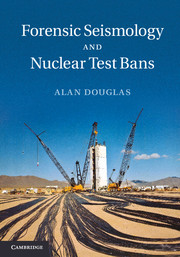Book contents
- Frontmatter
- Contents
- Preface
- Abbreviations and mathematical symbols
- Prologue
- 1 Seismology: ancient and modern
- 2 Statistical solutions to seismological problems
- 3 Seismograms as time series
- 4 Seismographs and seismograms
- 5 Seismometer arrays and processing methods
- 6 Seismogram interpretation and synthesis
- 7 Hypocentres and P travel times
- 8 Seismic magnitudes
- 9 Seismic source identification
- 10 Epilogue
- Appendix A P and S radiation from a double-couple source
- Appendix B Normal equations for analysis of variance
- Appendix C Some uses of the FFT
- Appendix D Anelastic attenuation
- Appendix E The relation of the transient and steady-state responses
- Appendix F Seismometer–galvanometer systems
- Appendix G SNI from summing array recordings
- Appendix H The equations for computing MP filters
- Appendix I Circular arrays
- Appendix J Geometrical spreading when S reflects as sP
- Appendix K The Fourier integral for a dispersed wave train
- Appendix L Tables of explosions and earthquakes
- Appendix M Album of body-wave seismograms
- Appendix N Exercises
- References
- Further reading
- Author index
- Index
8 - Seismic magnitudes
Published online by Cambridge University Press: 05 March 2013
- Frontmatter
- Contents
- Preface
- Abbreviations and mathematical symbols
- Prologue
- 1 Seismology: ancient and modern
- 2 Statistical solutions to seismological problems
- 3 Seismograms as time series
- 4 Seismographs and seismograms
- 5 Seismometer arrays and processing methods
- 6 Seismogram interpretation and synthesis
- 7 Hypocentres and P travel times
- 8 Seismic magnitudes
- 9 Seismic source identification
- 10 Epilogue
- Appendix A P and S radiation from a double-couple source
- Appendix B Normal equations for analysis of variance
- Appendix C Some uses of the FFT
- Appendix D Anelastic attenuation
- Appendix E The relation of the transient and steady-state responses
- Appendix F Seismometer–galvanometer systems
- Appendix G SNI from summing array recordings
- Appendix H The equations for computing MP filters
- Appendix I Circular arrays
- Appendix J Geometrical spreading when S reflects as sP
- Appendix K The Fourier integral for a dispersed wave train
- Appendix L Tables of explosions and earthquakes
- Appendix M Album of body-wave seismograms
- Appendix N Exercises
- References
- Further reading
- Author index
- Index
Summary
Let him that hath understanding count the number of the beast.
Revelations of St. John the Divine, 13:17-18Introduction
It is unlikely that many seismologists given a choice between seismic magnitude and some physical measure of seismic-source size would choose magnitude. As Thirlaway (1973) notes, some of the founders of seismology regarded seismic amplitudes as not worth serious study and since then others have argued that magnitudes should no longer be used (Jones, 2000). The main disadvantage of the magnitude scale is that it is not based on the physics of the source. It is an arbitrary scale; there is no wrong answer. Seismologists are therefore free to propose modifications to the scales. Scales defined on one type of recording system or component of ground motion, for example, are simply applied without change to new systems or components, which often then leads to attempts to relate the different scales.
Further, how A and T should be measured is often only loosely defined. Consequently, what is measured depends on analyst interpretation of the rules, and rarely are corrections applied to allow for: departures in the propagation path from some average structure; station effects; or the effects of earthquake radiation patterns. So it is easy to make the argument for abandoning magnitude as a measure of the size of a seismic disturbance and turning to physical measures such as seismic moment, which is based on the source physics and in theory at least, is independent of radiation patterns and Earth structure.
- Type
- Chapter
- Information
- Forensic Seismology and Nuclear Test Bans , pp. 299 - 339Publisher: Cambridge University PressPrint publication year: 2013



